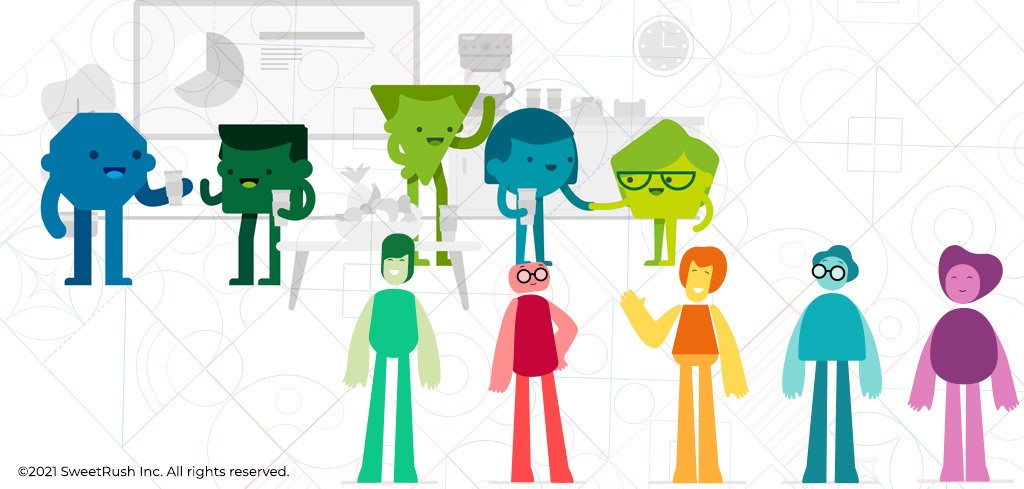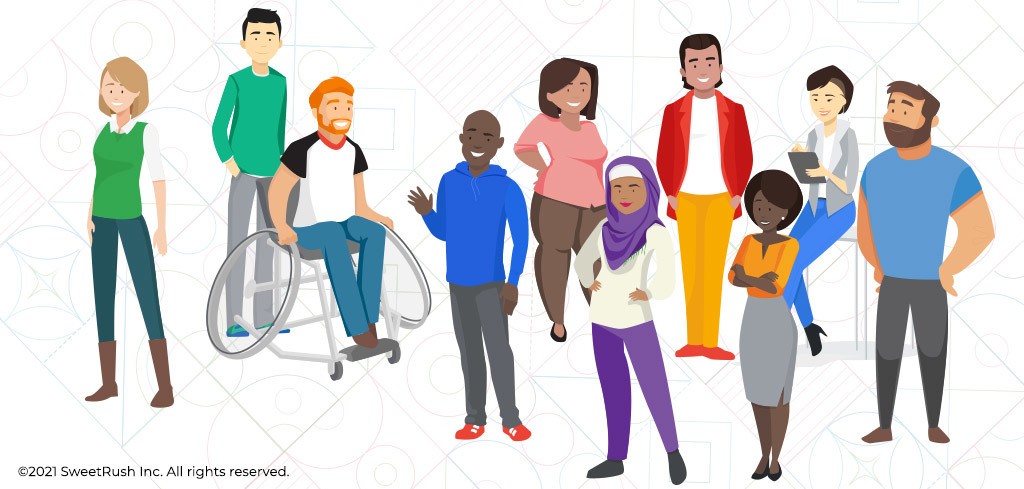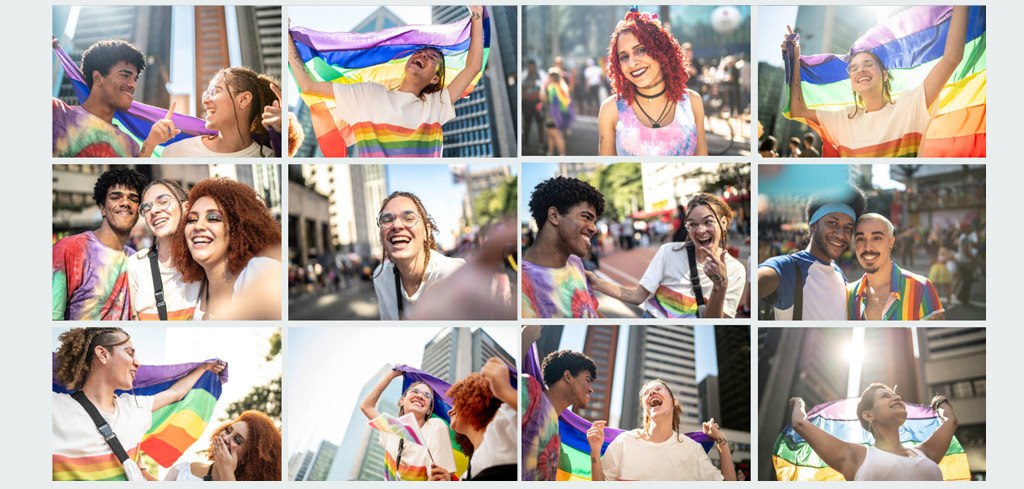Evolving Design Toward Inclusivity
Why is so essential to address the needs of your diverse audience for virtual training? Movements such as #OscarsSoWhite and #RepresentationMatters continue to shine a light on the lack of inclusion and the negative portrayal of underrepresented populations in media and entertainment. While academic research and opinion pieces tend to focus on representation in TV and movies, it’s up to all of us in the Learning and Development field to widen the lens and include virtual training as another way that people see themselves on-screen.
With more and more learning experiences shifting to the virtual and digital space, along with a renewed focus on storytelling, we have an opportunity to make a difference. Right now.
Carefully designed and selected imagery and audio can make or break the experience. Get it right, and we win the hearts and minds of our audience as they observe and interact with characters that they recognize, can relate to, empathize with, and even root for! Get it wrong and we risk alienating our audience. Disenchanting them. Turning them off. Or, in the worst-case scenario, angering or discriminating against them.

Bringing Diverse Characters To Life: 10 Tips To Improve Inclusivity And Diversity In Imagery And Voice-Over
So, how do we walk this fine line and make sure that we are promoting diversity and inclusivity in our on-screen characters? How do we create experiences that feel authentic and relatable? And how do we avoid stereotypes and bias?
For answers to these questions and more, read on as our team shares their top 10 tips for improving inclusivity and diversity in imagery and voice-over. Our approach is to continue to be open and learn about representation, and how we can do better. And we’re grateful for our client-partners and team members who collaborate with us and help us grow.

Tips For Improving Diversity And Inclusion In Illustration
The wonderful thing about illustration is that it provides total flexibility in all aspects of visual character development, from style and color to appearance, accessories, and context. But that doesn’t mean it can’t be tricky to get right.
We asked SweetRush’s 2D Team Lead, Jose Redondo, to share what he’s learned about improving diversity and inclusion in his designs. Here are his top tips.

1. Give Depth and Personality to Your Characters Using Backstories
At SweetRush, our Instructional Designers and Creative Directors are spending more and more time working on characters’ in-depth backstories. They begin by sketching them out on a virtual whiteboard before introducing them to the illustrators. Jose credits this additional step with making the illustration process more meaningful and inventive: “Rather than just focusing on appearance, the characters’ personalities shine through in the details. They become individuals, and we find that our teams treat and protect the characters as if they are real people.”

2. Stop and Ask: Does This Look Right? Does This Feel Right?
When you are working with custom illustrations, it’s even more important to pay attention to the details.
The image shown here didn’t always look like this. In an earlier iteration, the Black character was kneeling on the floor. As Jose recalls, “We recognized we had unintentionally put him in a submissive pose, which could be offensive.” After noticing this, Jose and his team revisited the image and made adjustments. The team also added a new checklist item, character placement, to their list of considerations when moving forward with other designs and projects.
The key takeaway here is to pause at various stages of your character design and development to check in and ask, Does this look right and does this feel right? If it doesn’t look right and it doesn’t feel right, it probably isn’t right. The more you start looking, the more you will start noticing!
3. Consider Using Genderless Illustrations and Cartoons

We’re seeing a trend towards the use of dolls and cartoons in our courses, as Jose explains in this example. “On the left, you see an illustration of the human body. The content—which was for a health care program—wasn’t specific to men, but we used an illustration of a man. On the right, you see a doll, which is also an illustration of the human body but with fewer gender-specific characteristics.”

Taking the concept of genderless representation one step further for your diverse audience in virtual training, are cartoons.
Cartoons are a great option to consider when realism isn’t critical to the storytelling. They're also a great standby if the subject matter is sensitive and there is a risk of representation being taken out of context. As Jose explains: “We don’t ever want to connect a particular problem—let’s say, aggressive behavior or sexual harassment—to a specific race, ethnicity, or gender. We don’t want to create or imply a subtext by unintentionally representing a specific group in a negative way.”

4. Treat Your Characters with Respect
Our final tip from Jose is quite simply to “treat your characters with respect.” Consider them as representations of real people, rather than lines on a digital page. Understand their backstories, dreams, and desires. Find ways for them to express themselves in unique ways as individuals. Each of us is unique, and so are your characters, no matter what they are representing.

Tips For Improving Diversity And Inclusion In Stock Photography
While illustration gives you the most amount of flexibility and nuance when it comes to representation in visual design, many clients still prefer to use photographs. If your client doesn’t have a photo library for you to work from (always ask this question first!), stock photography is your next best option.
SweetRush’s Design Lead Rolando Barrantes and Instructional Designer Heidi Green share their top three tips for improving inclusivity and diversity when selecting stock photos.
5. Show Individuality and Keep It Natural
Our first tip is about individuality. We don’t all show up to the office—well, when we show up to an office—in crisp, white, button-down shirts and black slacks. Everyone you encounter in the workplace is an individual. Unfortunately, a lot of stock photographs show workers looking and dressing in a similar way.
Rolando suggests looking for images that represent individuality and give learners a vision of themselves on-screen—and avoiding photos that are “too staged with pretty, perfect people.” Try to find candid images that show a wide variety of people in their natural environment and state. Try adding the words casual, informal, or candid to your next image search, and see what comes up!
Of course, if your diverse audience for virtual training is formal and their people dress formally, you can stick to the crisp, white button-down!
What to Avoid

Avoid using staged, “perfect” images that lack individuality.
What to Include

Opt for images that are unstaged and that show people’s individuality.
What to Avoid

Here’s another example of a staged perfect image that lacks individuality.
What to Include

In contrast to the example above, this unstaged, candid image feels authentic. We can see each person’s individuality, so that your diverse audience for virtual training can connect.
6. Dig Deep and Put In the Time
Searching for stock photos may seem like a straightforward task, but finding the right combination of photos that represents the audience and their individuality will take some time. Our team’s advice: be prepared to put in the legwork.
As Rolando notes: “It can be difficult to find a good photo that fits the context. You need to have a mindset of wanting to find something different.”
Heidi agrees: “So many stock photos represent white, able-bodied, cisgender people. It’s harder to have diverse representation in photos. You have to spend more time digging. You may have to compromise on other aspects of what you want to show, just to have people of color. Overrepresenting people of color can be very powerful because they are discounted in society and the white psyche. It makes the audience think.”
7. Find Your Photo-Based Avatar First, Then Write Their Story
Finding a one-off stock photo for an individual screen or slide is pretty easy. It’s a much bigger challenge, however, to find a stock-photo-based avatar/character that can be used over and over again in multiple situations, complete with emotions and facial expressions to match.
Instead of trying to make photos fit with your story, Rolando recommends finding the photo series first. “Find a character that will work in your story first, then write the backstory of that character to fit the photos.”
This may feel counterintuitive—particularly if you’ve read our tips for working with illustrations and creating backstories first!—but it’s an elegant solution when you don’t have control over the images.
The good news is that most online stock photography sites have features that enable you to find groups of similar photos or, better yet, multiple images from the same photo shoot. This can really speed things up once you have found an image that works as your starting point.


Diverse Audience For Virtual Training: Improving Diversity and Inclusion in Voice-Over
The increase of diversity and representation in virtual training illustrations and photos translates to more diverse needs for voice-over talent—and the SweetRush audio voice-over pool has grown and evolved to meet those needs.
Matt Leo and Scott Shankland from SweetRush’s Audio team share their top tips for improving inclusivity and diversity in audio.
8. Build a Diverse Talent Pool
If you’re primarily using internal talent, Matt’s advice is to see if you can branch out to using voice-over actors.
“We are always on the lookout for great talent that represents our diverse audiences. At the same time, we expand our talent pool slowly and selectively to ensure the quality, reliability, and versatility of our active voices. We receive hundreds of voice talent applicants, and our talent pool now includes around 60 people.”
9. Be Prepared to Find More Specific Voices

As diversity increases in stories and scenarios, more specific voices will be needed. This is typically a combination of characteristics—for example, a male with an Indian accent in his 20s, who is very warm and friendly.
According to Scott, the biggest trend that we’re seeing is a need for younger-sounding voices. “More learners will be in the Gen Z or young millennial age range, and we want to represent them in our characters and narrators on-screen,” he says.
One way to get in front of these needs is to share any character backstories with the Audio team early so that they can assess their talent pool and assemble demo reels to share with the client alongside the images.
10. Consider Using Natural Speakers
Rather than asking actors to change their voices dramatically, Matt recommends honing in on the actors’ natural speaking voices and casting them in roles that match their voice. This helps create a more conversational tone.
“We have some really versatile actors who can do a range of voices—even something like a parrot or a robot. But since the beginning, we’ve tried our best to hire people who we can cast in different roles to speak in their natural voices. And thankfully, 99% of the time, we nail it and deliver exactly what our client is hoping for.”
That concludes our top tips. When learners can identify with the characters in your training programs—when they can see and hear themselves represented authentically and thoughtfully, with caring and respect—they will feel included.
Final thoughts: Be considerate and intentional in your approach, and then reflect on your choices and decisions—do that final pass through and question everything. And be open to feedback and continue to learn and do better.
Need some inspiration? Check out our eBook, Virtual Training, SweetRush Style: 5 Case Studies to Inspire a Learner-Centered Approach, for stories and visuals on how five different organizations brought their characters to life. Also, watch the webinar about SHRM’s PMQ virtual learning program to take your leadership training to the next level.


